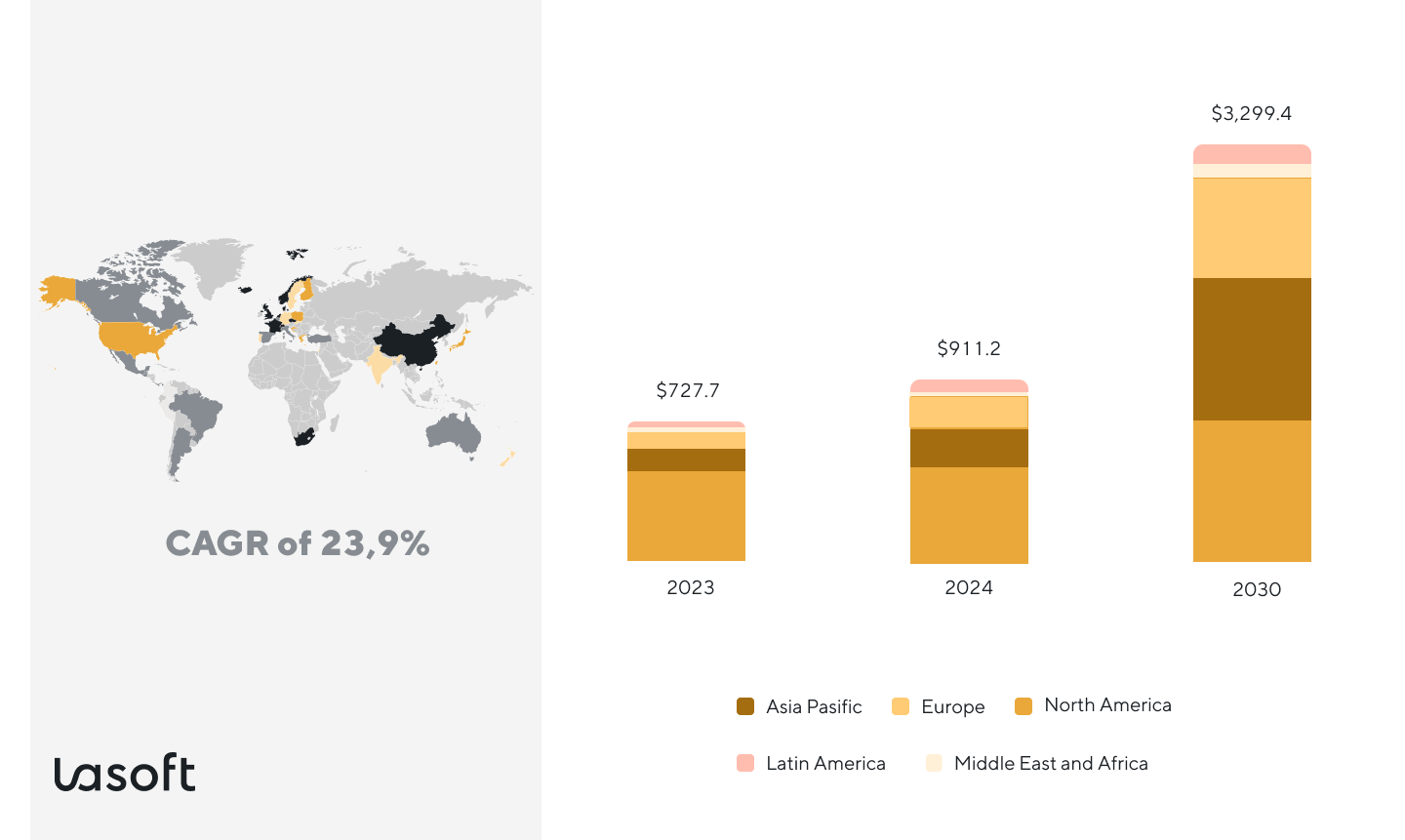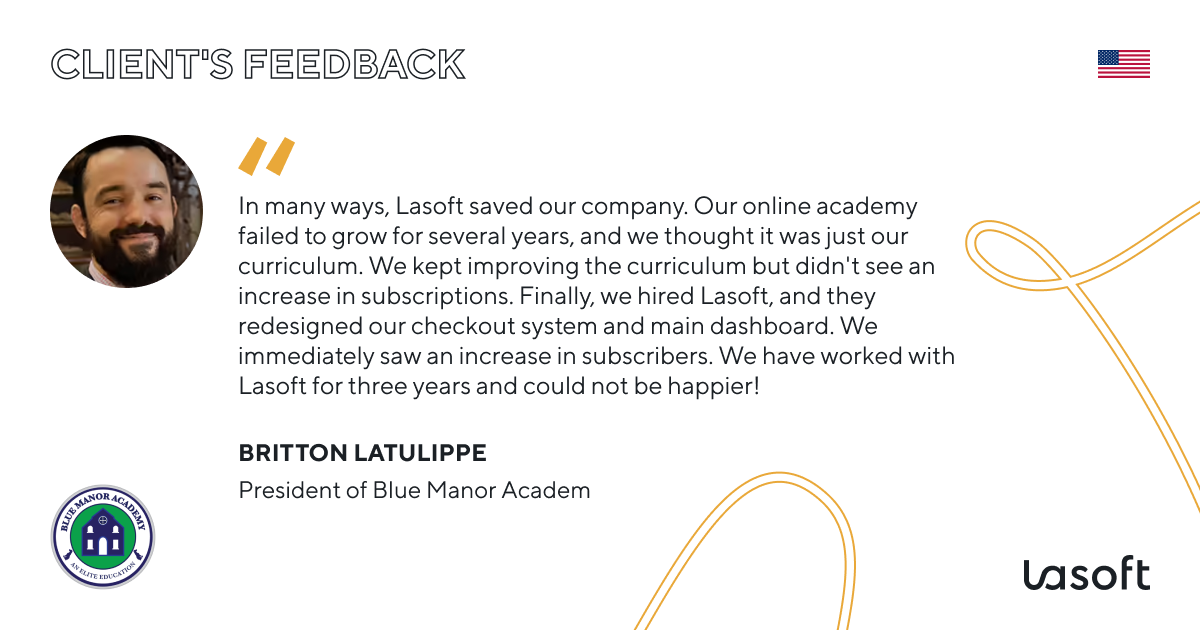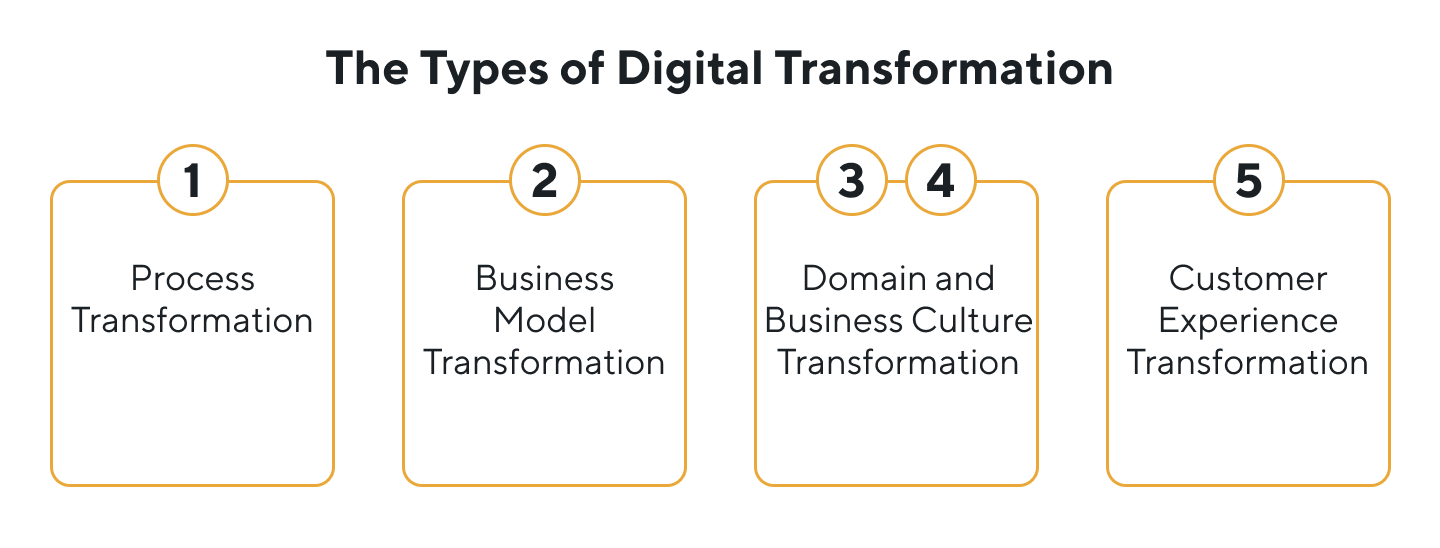Businesses integrate digital technologies to automate routine workflows, elevate customer interaction 24/7, and transform complex data into valuable insights and understandable reports. Digital transformation delivers value to businesses by offering secure solutions for sensitive data, increasing productivity, reducing labor costs, time, and effort, and building client loyalty by improving their experiences and support.
Adopting technologies like cloud computing, artificial intelligence (AI), big data, the Internet of Things (IoT), and automating routine tasks to optimize business operations changes the company’s position among competitors to be more agile, customer-focused, and data-driven. Let’s explore some useful statistics and successful examples of digital transformation, such as the Blue Manor Academy case or the CommUNIty social network by the LaSoft team.
Digital Transformation Market Forecast
The digital transformation market is experiencing rapid growth, with its market value expected to increase from approximately USD 911.2 billion in 2024 to USD 3,289.4 billion by 2030. The development of digital public infrastructure (DPI), the growing demand for operational efficiency, and the increasing adoption of advanced technologies to meet rising customer demands are driving this remarkable growth, which will occur at an annual rate of 23.9% from 2024 to 2030.

Source: Marketsandmarkets
What Are the Types of Digital Transformation?
Digital transformation involves integrating digital technology into any business area, fundamentally changing how it operates, and delivering value to employees and customers. It’s more than just updating technology; digital transformation means rethinking business models, processes, and business culture to adopt new, more efficient, more agile ways of working.
Businesses in different industries want to be more efficient, improve customer experiences, and introduce technologies like cloud computing, artificial intelligence, big data, automation, and the Internet of Things (IoT).
- Process Transformation: modernizing existing business processes to be more efficient and reduce costs. Examples include automating workflows, using data analytics, or adopting artificial intelligence (AI) to simplify things.
- Business Model Transformation: changes the core business model to meet market needs and use digital opportunities. This might include launching subscription models or online platforms and transforming the digital strategy for services and products.
- Domain Transformation: expands into new digital markets or domains outside its traditional industry. For example, a retail company is adopting tech-based software or data analytics solutions.
- Business Culture Transformation: focuses on changing the company culture and getting a digital mindset across the teams. This might include innovation, upskilling employees, and agile practices to adapt to digital change.
- Customer Experience Transformation: how any company interacts with customers. Digital tools like CRM, personalization, and 24/7 automated customer support.
Digital Transformation Initiatives, Key Areas, and Tools
Digital transformation enters multiple business areas, helping to stay competitive, improve efficiency, and meet the changing market trends. What are the key areas where digital transformation offers a competitive advantage?
Personalized Customer Experience
AI and big data analytics help understand behavior and deliver a personalized customer experience. These tools provide seamless interaction with clients across multiple channels, such as mobile, web, and social media. AI assistants through chatbots offer 24/7 customer service, improving response time and streamlining communication.
Data Management and Analytics
Big data advanced analytics helps gather and analyze large data sets, while predictive analytics uses historical data to forecast future trends, customer behaviors, and business operations outcomes. Businesses choose to migrate to the cloud to provide cloud infrastructure management and store data securely and efficiently, such as AWS, Microsoft Azure, or Google Cloud. These scalable cloud solutions improve business processes and make data accessible from anywhere while reducing on-premise infrastructure costs.
Agile Collaboration Tools
Tools like Microsoft Teams, Slack, Jira, Trello, Miro, Zoom, Google Meets, etc. enhance communication and collaboration among internal team members or dedicated teams, especially in remote work environments.
Cybersecurity
Businesses’ digital transformation brings advanced security protocols, such as encryption, multi-factor authentication, and secure cloud storage, to protect sensitive data. AI and machine learning can detect anomalies and security threats in real-time, helping businesses respond to cyberattacks faster.
Change in Business Models
Another area for business transformation is shifting from traditional retail to e-commerce or launching digital platforms catering to new market segments. Many companies are adopting subscription-based models or offering on-demand services, increasing customer retention and providing consistent revenue streams.
Supply chain management and logistics implement IoT and blockchain technologies to improve supply chain tracking, transparency, and management. Some businesses in the financial or banking sectors implement blockchain technology to create decentralized platforms or use smart contracts to manage secure transactions and reduce third-party intermediaries, offering a substantial competitive advantage.
Business Digital Innovation Real World Examples Across Industries
| Industry | Use Case Examples | ||
|---|---|---|---|
| Insurtech | AI-Powered Claims Processing: AI automates claims evaluation, reducing process time and improving customer experience. | Blockchain for Policy Management: Secures contracts and automates renewals |
Chatbots for Customer Service: AI-driven chatbots provide 24/7 customer support. |
| Fintech | Blockchain for Secure Payments: Provides transparent and secure financial transactions. | AI for Fraud Detection: Analyzes data to detect suspicious activities. |
App for Mobile Banking: Offers clients multiple benefits and seamless banking services via mobile apps. |
| Martech | Personalized Customer Journeys: Uses AI to create marketing messages based on customer data. | Predictive Analytics: Predicts potential customer behaviors and trends. |
Marketing Automation: Automates email campaigns, lead interactions, and customer segmentation. |
| Education | AI-Driven Personalized Learning: Customizes lessons based on student progress. | Virtual Classrooms: Enables remote learning through online platforms. |
Gamified Learning: Uses game mechanics to make education more engaging and fun. |
| Telecom | 5G for IoT Connectivity: Enables high-speed, low-latency connections for smart devices. |
AI for Network Optimization: Improves network performance and predictive maintenance. |
Cloud-Based Communication Services: Offers scalable voice, video, and data services via the cloud. |
| Fitness | Wearable Health Trackers: IoT devices track fitness levels and health data in real-time. | AI-Driven Personal Trainers: Provide personalized workout plans based on user data. | Virtual Fitness Classes: Offers on-demand fitness classes via mobile apps. |
| Real Estate | VR Property Tours: This feature allows potential buyers to view properties remotely using VR. |
AI for Property Valuation: Uses data to predict property values and trends. | Blockchain for Smart Contracts: Secures and automates real estate transactions. |
| HR | AI for Recruitment: Automates resume screening and candidate matching. |
HR Analytics: Uses data to optimize talent management and improve employee retention. | Employee Engagement Platforms: Provides real-time feedback and engagement metrics to improve workplace culture. |
Blue Manor Academy: EdTech Digital Transformation Example
Blue Manor Academy (BMA), an educational platform based in the United States, approached LaSoft to improve the performance and quality of its existing web platform. Unsatisfied with the first vendor’s technical delivery, the BMA team sought LaSoft’s expertise to redesign the platform and introduce significant improvements.
LaSoft’s developers focused on improving the platform’s UI-UX, updating data libraries, and conducting comprehensive code refactoring. Using our expertise in software architecture, our team transitioned the platform from a monolithic structure to a more scalable and resilient microservices architecture, laying the groundwork for future growth and expansion. The digital transformation resulted in an updated edtech platform that provides an improved user experience for students, parents, and academy staff.
Key Achievements and Features Implemented
LaSoft’s dedicated team worked diligently to implement new features and enhancements, which included:
Comprehensive Dashboard: A user-friendly dashboard featuring clear data visualizations, enabling parents to easily track their children’s progress and gain insights into their educational journey.
Peer-to-Peer Video System: An innovative peer-to-peer video communication system was introduced, facilitating seamless interaction and collaboration between students and educators within the BMA community.
Customizable Curriculum: The platform now offers a customizable curriculum, empowering educators to personalize learning materials to suit each student’s unique needs and preferences.
User-Friendly Library: A vast collection of books is now accessible through a user-friendly library interface, enhancing the learning experience and broadening the knowledge base for BMA users.
Progress and Tracking: The platform now includes detailed progress tracking, goal setting, and a notification system to ensure parents and students stay on track.
Migration to Microservices: LaSoft successfully migrated the platform to a microservices architecture, improving scalability, flexibility, and overall performance while simplifying the development and deployment processes.
System Maintenance and Continuous Improvement: LaSoft continues to provide ongoing maintenance and support, ensuring that the platform remains optimized, secure, and updated with the latest technologies and trends.
Intuitive Admin Panel: LaSoft developed a streamlined admin panel that simplifies content management. This panel allows administrators to efficiently manage course materials, user accounts, and other platform components.
Gamification: LaSoft integrated gamification elements into the platform’s training modules, making learning more engaging and interactive and fostering students’ sense of accomplishment and motivation.

Example of Gamification in the Edtech Digital Transformation Projects
In Blue Manor’s EdTech platform, LaSoft implemented a gamification of innovative solutions through the Memorization feature, enhancing the learning experience by making it engaging, motivating, and rewarding. Below is an overview of how gamification was integrated into this feature:
“Memorization” category for students
A list of memorization subjects (such as speeches, poems, historical facts, or Bible verses) allows students to choose what they want to learn, with administrators adding more subjects over time.
Progress Tracking and Motivation
For each memorization subject, students can see their progress using a progress bar that updates as they complete each lesson. For each memory quiz, students can view the coins they have earned and the total coins they can earn, creating a sense of achievement and encouraging them to keep learning.
By categorizing memory tests by grade level, students can concentrate on material relevant to their knowledge level. If more than six quizzes are available, students can slide through them to view additional options. Students can see their progress for each quiz, knowing exactly how much they have completed and what remains. For every memory quiz, students can see how many coins they’ve earned versus how many they could earn, further motivating them to complete quizzes and improve.
Memory Quiz Structure
When students select a specific memory quiz, a popup will show the contents, allowing them to understand the quiz requirements before they start. Large quizzes (such as long poems) are put into smaller parts (e.g., 4–6 lines). It makes the learning process more manageable by allowing students to complete lessons step by step. Students see an indicator of which parts have been completed, helping them track their progress and stay focused.

Transforming Campus Life with CommUNIty: An AI-Powered Social Network for Higher Education
In an academic environment, universities and colleges need more than static LMS systems or overburdened email threads. The Lasoft team researched the edtech market needs and developed an off-the-shelf solution, CommUNIty. Our AI-managed internal social platform redefines digital campus life by facilitating interactions between teachers, education staff, administrators, and students. Let’s explore the benefits our clients gain by implementing this solution.
Streamlining Administrative Workflows
Gone are the days of digesting masses of emails and pinging through slow LMS interfaces. With CommUNIty, routine questions, such as course deadlines, exam times, webinar links, or department announcements, are handled instantly by an AI assistant trained to understand academic language and context. The advantage is obvious, professors spend less time repeating answers and more time focused on teaching. Administrators gain visibility into trending inquiries, enabling them to address concerns and prioritize policy updates preemptively.
Elevating Student-Faculty Interaction
CommUNIty is designed like a private social network, mirroring platforms students already know. Students post questions, share ideas in group chats, or message instructors directly. Behind the scenes, the AI agent organizes these conversations, surfaces patterns, and nudges faculty to respond. It sends real-time notifications for assignment changes or upcoming events, ensuring students stay informed and engaged.
Personalizing Academic Support at Scale
CommUNIty’s AI bridges that gap by analyzing sentiment in posts, flagging signs of disengagement or confusion. It surfaces personalized learning suggestions and reminds students about critical academic milestones.
Amplifying Learning Beyond the Classroom
The platform supports profile pages for professors and courses, acting like a dynamic directory where students can explore faculty of interest and access office hours. Event and webinar notifications appear in personalized feeds, while integrated calendars and reminders ensure learners never miss a workshop or consultation.

Why CommUNIty Works Where Traditional Tools Fall Short
| Familiar UI, Education-first Design | Students interact via a social media-style interface, but tailored to respect privacy and academic structure. |
| AI That Serves, Not Replaces: | The assistant handles routine tasks, freeing staff for creative teaching. |
| Data-Driven Support: | Engagement analytics and sentiment insights let educators understand student needs. |
| Built for Scale and Compliance: | From colleges to entire university systems, CommUNIty grows with your institution while honoring privacy standards. |
How Does Business Benefit from Digital Transformation Strategies?
The company elaborates on a digital strategy to change business processes and integrate current digital technologies into all operations. Digital transformation experts start implementing agile practices, changing business processes, becoming efficient, and facing market challenges.
Operational Efficiency
Robotic process automation (RPA) and artificial intelligence (AI) enable companies to automate repetitive tasks, including data entry, invoicing, digital communication with target audiences, and reporting, thereby reducing manual errors and streamlining processes. Digital tools such as Enterprise Resource Planning (ERP) systems integrate different business functions (finance, HR, supply chain) into a unified system to streamline operations. It impacts better coordination, fewer silos, and a faster problem-solving process.
Customer Relationship Management
Big data and AI help gain insights into customer preferences and behaviors. AI assistants help offer personalized products, services, and recommendations. This 24/7 service enhances customer satisfaction and grasps all possible channels to build brand loyalty.
Become a Data-driven Company
Businesses can use big data to gain real-time insights into market trends, customer behavior, and operational performance, enabling them to make faster strategic decisions. By leveraging machine learning and AI, companies can predict customer needs, anticipate trends, and make proactive business decisions, which helps in optimizing inventory, marketing strategies, and product development.
Risk Management, Agility, and Flexibility
Cloud computing enables businesses to secure sensitive data and adapt to market changes, customer demand, and competitive environments. It also allows for rapid scalability, making launching new products, services, or business models easier. Companies use software-as-a-service (SaaS) platforms to create business environments and implement new tools or systems more quickly, reducing downtime and increasing responsiveness to emerging challenges.
Sustainability
One of the driving forces behind digital processes is the increasing focus on sustainability. Businesses are making efforts to reduce their environmental impact. For example, companies use digital tools to create more efficient, sustainable supply chains by optimizing energy use, reducing waste, and minimizing carbon emissions. Document management systems and cloud storage minimize paper usage and improve sustainability efforts.
New Business Models
Digital transformation allows companies to experiment with new business models such as subscription services, digital platforms, or e-commerce channels. These models are designed to integrate payment systems, making it convenient to pay for a subscription. For example, traditional retailers can embrace e-commerce or adopt a direct-to-consumer model through digital platforms.
Cost Savings
Despite costs of transformative, innovative solutions that optimize workflows, businesses reduce operational costs in the long run. Cloud-based solutions eliminate the need for expensive on-premise infrastructure, and automation reduces labor costs. Automation and AI help reduce human errors, minimizing costly mistakes in areas such as inventory management, billing, and customer service.

Successful Example of Digital Transformation Roadmap
Suppose you plan to implement changes in your business operations and start a digital journey. In that case, you should consider a digital transformation roadmap that describes the step-by-step process a business will follow to successfully integrate new technologies into its operations, culture, and business model. The roadmap helps ensure that the transformation is strategic, structured, and aligned with the company’s long-term goals.
Define Your Goals and KPis
- What do you want to achieve with digital transformation?
- How will success be measured with key performance indicators?
The first step in any digital transformation journey is defining your goals. Identify how digital transformation will align with your company’s mission and the value it will create for your customers. Establish specific goals, such as improving customer experience, increasing operational efficiency, or expanding into new markets.
Assess Current Digital Maturity
Assessing your company’s legacy system and digital readiness is crucial before implementing new digital tools. Your team should not only accept changes in the workflow but will also actively participate in implementing new processes. You’ll need to provide training and workshops for your team members to ensure they understand the benefits of amendments. Compare your digital potential against industry standards or competitors. You can conduct market research or learn from the practices and experiences of successful businesses in your niche. Highlight the areas where improvements will help achieve your digital goals.
Create a Digital Strategy
Once you understand the current state and have defined your objectives, you can build a digital strategy. Identify key digital projects or technologies (e.g., cloud computing, AI, big data, automation) that align with your goals. Prioritize them based on their business impact and feasibility. Enhance customer experience through personalization, convenience, and seamless channel interaction. Stick to an agile strategy that can adapt to changes in technology or market demands. It would be better if you found a dedicated team to help you implement changes in the company’s internal processes.
Dedicated Team vs In-house Team
A dedicated team model offers specialized skills and expertise to ensure that digital transformation is executed efficiently and aligns with your company’s goals. Businesses usually rely on a dedicated team of experts with in-depth knowledge of cutting-edge technologies like AI, blockchain, cloud computing, and data analytics. A dedicated team focuses entirely on your project, enabling them to create customized solutions to your business’s specific challenges. They don’t follow a one-size-fits-all approach; instead, they design a strategy tailored to your industry, goals, and customer demands.
Digital Transformation Efforts from a Dedicated Team vs an In-House Team
| Factors | Dedicated Team | In-House Team |
|---|---|---|
| 1. Cost Efficiency | Hiring a dedicated team offers an option to avoid the costs of recruitment, training, and onboarding of new employees. You pay only for the required expertise and hours, making your partnering cost-effective. | Building an in-house team requires substantial investment in recruitment, salaries, and bonuses. Extra costs you bear include office space, equipment, and continuous training. |
| 2. Expertise | Dedicated teams already possess skills in areas such as AI, cloud services, blockchain, and marketing automation, and have experience with full-cycle services and digital transformation cases across various industries.
They stay updated on the latest technologies and trends, giving professional advice on your possible business outcomes. |
Finding professionals with the full range of expert skills needed for digital transformation may be challenging and time-consuming.
Internal teams will need continuous training to stay up-to-date with evolving technologies. |
| 3. Speed of Implementation | A dedicated team is already skilled and manages agile workflows, allowing them to begin work immediately and deliver results quickly. | Recruiting, onboarding, and training an in-house team takes time, leading to delays in starting the digital transformation process. |
| 4. Flexibility and Scalability | Can easily scale up or down based on your project needs, offering flexibility as your transformation evolves.
They are adept at adjusting to changes in the project and shifting priorities. |
Scaling an in-house team requires additional recruitment efforts and costs.
May not be as agile when adapting to changes in the digital transformation strategy. |
| 5. Time to Market | With experience in similar projects, a dedicated team can implement new initiatives more quickly, thereby reducing the time to market for new digital products or services. | Learning new technologies requires time, which can delay the rollout of new digital solutions. |
| 6. Risk Mitigation | They have expertise in cybersecurity and compliance, which helps minimize risks associated with digital data breaches or regulatory violations. | Data protection and compliance might require additional investments in training and technology for the in-house team. |
| 7. Ongoing Support | Dedicated teams often provide post-launch support, ensuring that the implemented systems run smoothly and are optimized. | Often must continuously monitor and maintain new systems, which could distract them from other priorities. |
Launching a New Digital Product (App or Platform)
As a part of your digital transformation efforts, when launching a new digital product to the market, such as an app or platform, a dedicated team helps with a smooth transition from concept to deployment. The team undertakes essential tasks to ensure the product’s success, from migration activities and security measures to financial analysis and customer satisfaction monitoring. Below is a detailed description of each action involved in launching a new digital product through digital transformation.
Migration Activities
All relevant data from legacy systems is successfully migrated to the new platform. This includes customer information, transaction histories, product data, and other critical business information. Any existing systems, such as CRMs or ERPs, are integrated into the new platform to ensure seamless communication between platforms and maintain data consistency. If the new product is cloud-based, the team manages the cloud infrastructure migration of data and applications, ensuring scalability and flexibility.
Installation and Setup
The team installs all required hardware and software components, including servers, databases, and applications, to run the new product. Establishing and testing the network infrastructure to support smooth operations, ensuring efficient product performance without connectivity issues, and configuring the platform or app to meet business requirements, including user interfaces, workflows, and features tailored to customer needs.
Testing
QA experts conduct testing of the app or platform’s components (or units) to ensure that each part works correctly and independently. After unit testing, integration testing ensures that different elements of the app/platform work together smoothly, identifying any issues in communication between modules. They conduct user acceptance testing, which involves real users testing the product in a real-world scenario to ensure it meets their needs and functions as expected. Performance and loading testing assess how the product handles various levels of user traffic and ensure the platform remains responsive under peak loads.
Security Measures
An expert team implements encryption and other security protocols to protect sensitive data such as user information, financial data, and intellectual property. Robust authentication and authorization mechanisms (such as multi-factor authentication) are installed to ensure only authorized personnel and users can access the platform. Testers provide regular security testing, including such testing, which is conducted to identify and address any potential vulnerabilities in the app or platform.
Financial Calculations and Budget Management
During the discovery stage, i.e., the research stage, the business analyst calculates the overall cost of developing, launching, and maintaining the new product. Continuous expenditure tracking ensures the project stays within budget, and adjustments are made as needed during the development stage. The team defines and analyzes the new product’s revenue model, whether it’s based on subscriptions, one-time purchases, in-app purchases, or advertising by forecasting income per year.
Marketing Automation
Marketing campaigns include email marketing, social media promotions, online ads, etc. You choose which marketing strategies are implemented to encourage early adoption and increase user engagement, such as offering discounts, promotions, or free trials for early users. Your dedicated team can also integrate the necessary APIs, AI assistants, and other relevant technologies.
Final Recap
Embracing digital transformation enables traditional businesses to operate by integrating advanced technologies that automate workflows, meet customer expectations, and convert complex data into actionable insights. It provides secure solutions for data management, increases productivity, and reduces costs. Technologies such as cloud services, artificial intelligence (AI), big data, and the Internet of Things (IoT) enable business leaders to optimize operations, enhance employee satisfaction, and implement digital transformation initiatives, thereby increasing agility.
FAQ




